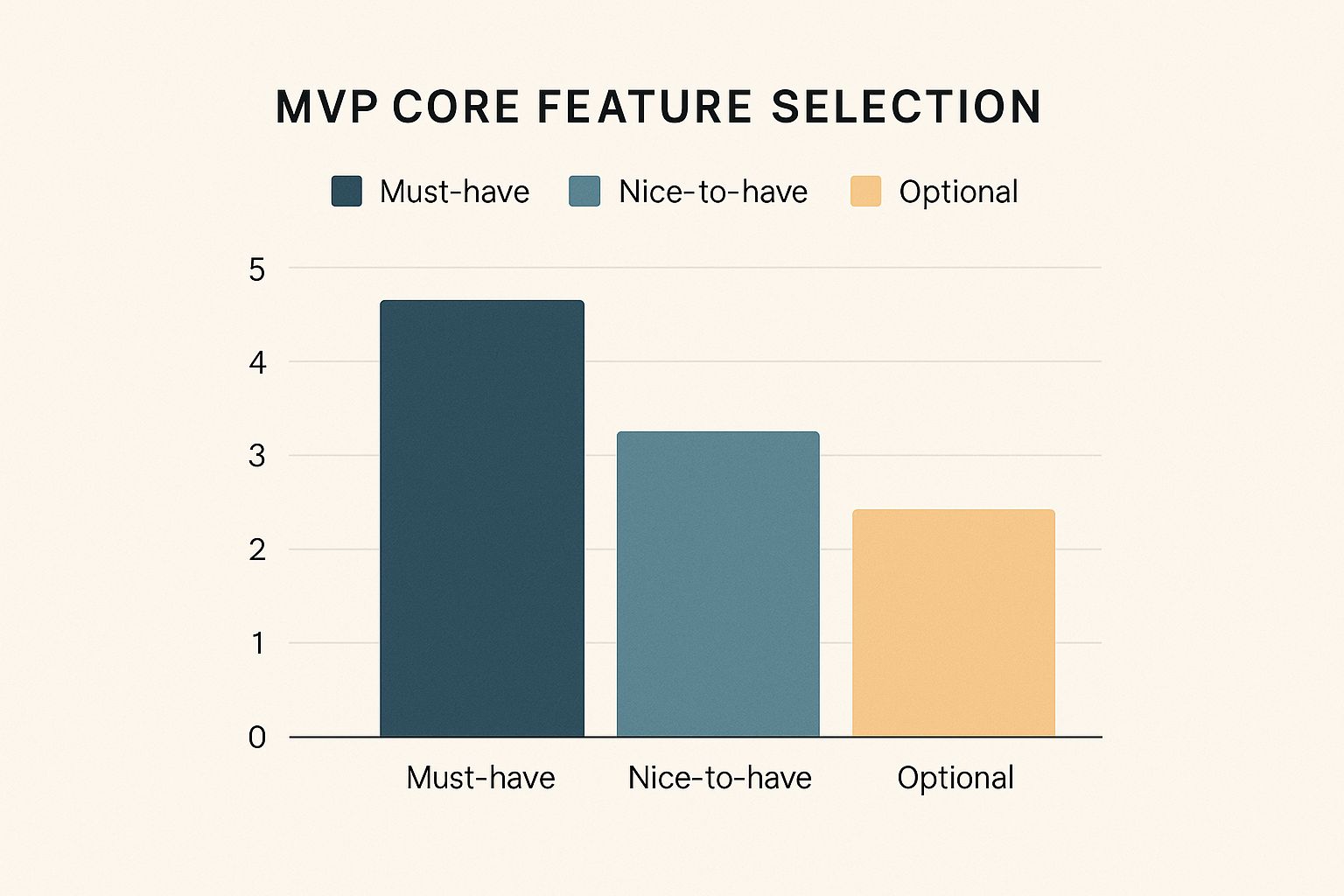How to Build a Minimum Viable Product: Expert Tips


Learn how to build a minimum viable product that validates your idea efficiently. Discover key strategies to turn concepts into successful solutions.
The Real MVP: Beyond the Buzzword

The term Minimum Viable Product (MVP) is common in the startup world. However, many founders misunderstand its true meaning, wasting resources and delaying crucial market feedback. A true MVP isn't a smaller version of your final product. Instead, think of it as a focused learning vehicle to test your core assumptions. This requires a shift from a product-centric approach to a learning-centric one.
Understanding the MVP Mindset
This approach comes from Eric Ries' Lean Startup methodology. Lean Startup defines an MVP as "a version of a new product which allows a team to collect the maximum amount of validated learning about customers with the least effort." The Lean Startup movement, popularized in the late 2000s and early 2010s, changed how startups develop products. By 2024, the global MVP development market was valued at approximately US$316 million, showing the growing importance of reducing risk and improving product-market fit. Learn more about the growing MVP development market: Global Minimum Viable Product (MVP) Development Market
Building an effective minimum viable product means identifying the absolute essential features for testing your most critical assumptions. Imagine building a social media platform. Your core assumption might be that users want a new way to share short-form videos. Your MVP wouldn't need extras like direct messaging or profile customization. It would focus solely on video creation and sharing.
Avoiding the Overbuilt MVP Trap
Many founders build an overbuilt MVP. This often comes from wanting to impress investors or fearing a "subpar" product launch. However, adding unnecessary features delays valuable feedback and increases development costs. Successful founders understand the difference between a validation tool and a finished product. They prioritize speed and learning over polish and completeness.
This means focusing on core features and resisting the urge to add "nice-to-haves" before validating core assumptions. Consider exploring real-world MVP examples: Minimum Viable Product Examples
This lean approach lets founders quickly gather user feedback and iterate based on real-world data. By focusing on learning, founders can confidently decide whether to pivot or persevere, ultimately increasing their chances of building a successful product. This sets the stage for a more efficient journey from initial concept to market validation.
Finding Your Problem Worth Solving
The foundation of a successful minimum viable product (MVP) hinges on identifying a problem worth solving. Many founders fall into the trap of building solutions for assumed problems, not validated ones. This disconnect often leads to wasted resources and, ultimately, product failure. This section explores how to effectively pinpoint genuine customer pain points and validate problem hypotheses before writing any code.
Understanding the Difference Between Assumed and Actual Problems
Building a successful minimum viable product starts with accurately defining the problem. Founders often make assumptions about user needs, leading to solutions that miss the mark. For example, a founder might assume users need a faster way to order groceries online. However, the real problem could be the lack of fresh, local produce available on existing platforms. This highlights the critical difference between perceived and actual needs.
Techniques for Uncovering Real Customer Pain Points
Effective customer interviews are key to uncovering real needs. These interviews should focus on understanding the "why" behind customer behaviors and frustrations. Instead of leading questions, use open-ended inquiries to encourage users to share their experiences. This provides deeper insights into the underlying problems driving customer behavior. Observing users interacting with existing solutions can also reveal unarticulated pain points.
Validating Problem Hypotheses Before Building
Before investing in development, validate your problem hypotheses. This can be done through various methods, including surveys, landing page tests, and even simple prototypes. These tests provide crucial early feedback and help prioritize the most pressing problems for your target audience. A landing page MVP, for instance, can gauge interest before a product even exists.
To help illustrate the various methods you can employ, take a look at the following comparison table:
Problem Validation Methods Comparison
| Validation Method | Time Required | Cost | Reliability | Best For |
|---|---|---|---|---|
| Customer Interviews | Medium | Low-Medium | High | Deep qualitative insights |
| Surveys | Low | Low | Medium | Gathering broad feedback |
| Landing Page Tests | Low-Medium | Low | Medium-High | Measuring initial interest |
| Prototypes | Medium-High | Medium | High | Testing specific functionalities |
This table summarizes the various validation methods available, each offering unique benefits and drawbacks. Choosing the right method depends on your specific needs and resources.

This infographic emphasizes prioritizing essential features. Focusing on a small number of must-have features (5) is more effective than including numerous nice-to-have (3) or optional (2) features in your MVP. This streamlined approach allows for faster validation of core assumptions and reduces development time. By prioritizing essential features, founders can quickly gather feedback and iterate based on real user data, increasing the chances of building a desired product. This sets the stage for a minimum viable product that effectively addresses a validated problem, leading to greater chances of success.
The Essential Features Formula

Figuring out the essential features for your minimum viable product (MVP) is a major challenge. Choosing what to include and what to postpone requires careful planning. A strategic approach ensures your MVP effectively tests core assumptions without unnecessary additions. This section explores proven frameworks for prioritizing features, helping you create a focused MVP that maximizes learning and minimizes wasted effort.
Prioritization Frameworks: Separating The Essential From The Excess
Successful founders use structured frameworks for prioritizing features. The MoSCoW method is a popular choice. This framework categorizes features into four priorities: Must have, Should have, Could have, and Won't have. This simple system helps teams objectively decide which features are crucial for the MVP's core functionality.
Another helpful tool is the impact vs. effort matrix. This matrix visually plots features based on their potential impact and the development effort required. Features with high impact and low effort are ideal for your MVP. They offer maximum value for minimal investment. Features with high effort and low impact should be saved for later. This visual approach provides clear, data-driven prioritization.
Learning From Founders: Successes And Pitfalls
Learning from others can save valuable time and resources. Successful founders often emphasize a ruthless focus on core features. They understand that too many features dilute the MVP's purpose and delay market feedback. Think of early versions of apps like Instagram or Twitter. Their initial releases focused on a single core function, proving their value before expanding.
Many founders have also learned about the dangers of feature creep. The "just one more feature" trap can delay launches and lead to overbuilt MVPs. These bloated MVPs fail to validate core assumptions. This can be costly, wasting both development time and market opportunities. Effective prioritization avoids this pitfall.
Staying Lean: Resisting The Urge To Overbuild
Building a successful MVP requires discipline. It's about resisting "nice-to-have" features before validating core assumptions. A successful MVP effectively validates market need and reduces failure rates. Research shows about 42% of startups fail due to a lack of market need. Focused MVPs, with core features and user feedback, validate these assumptions. One-third of MVPs fail, often due to poorly defined core features. The global MVP development market is projected to reach US$569 million by 2031. More detailed statistics can be found here: From MVP to Market: Real-world success and startup survival statistics. This highlights a focused MVP's importance for startup success.
This disciplined approach allows faster validation and quicker iterations. Ultimately, it increases the probability of creating a product that resonates with users. By focusing on what truly matters early on, founders maximize their chances of building a successful product.
Building Smart: Development Approaches That Work

Prioritizing features for your minimum viable product (MVP) is the first step. Choosing the right development approach is next. This decision balances speed, cost, and quality, impacting your MVP's success. Let's explore the options available to founders.
Agile Development: Embracing Flexibility
Agile development is a popular methodology for MVPs. Its iterative nature aligns with the MVP philosophy of learning and adapting. Instead of long development cycles, Agile uses short sprints. This allows teams to respond to user feedback and market changes.
For example, one sprint might focus on the core video sharing of a social media MVP. After feedback, the next sprint could improve the user interface. This constant feedback loop is key to agile development.
No-Code/Low-Code: Empowering Founders
No-code and low-code platforms have changed software development. Non-technical founders can now build functional MVPs. These platforms offer drag-and-drop interfaces and pre-built components. This reduces development time and cost. However, limitations exist in scalability and customization.
Rapid Prototyping: Quick Concept Testing
Rapid prototyping tests design and function before major development investment. It creates basic MVP versions for early user experience feedback. These range from paper prototypes to interactive mockups. This early feedback refines the product and identifies usability problems.
Addressing issues early leads to a better final product. Rapid prototyping lets founders quickly experiment with design and function, saving time and resources.
To help you choose the right approach, let's compare different MVP development methodologies:
MVP Development Approaches Comparison of different development methodologies for building your MVP
| Development Approach | Speed | Cost | Technical Complexity | Scalability | Best For |
|---|---|---|---|---|---|
| Agile Development | Medium | Medium | Medium | High | Complex projects requiring flexibility |
| No-Code/Low-Code Platforms | High | Low | Low | Low | Simple MVPs with limited scalability needs |
| Rapid Prototyping | High | Low | Low | Low | Testing design and functionality early on |
This table highlights the trade-offs between speed, cost, and complexity. Choosing the right approach depends on your project's specific needs.
Choosing The Right Approach
The best development approach depends on several factors. Technical complexity, team skills, budget, and market timing all play a role. A simple MVP might use a no-code platform. A complex MVP might need a dedicated team and an agile approach. Recent years have seen a shift towards agile methodologies and AI integrations. By 2025, lean and agile development, AI integration, and sustainability are becoming more common in MVP development. These trends allow startups to develop faster, meet user needs, and stay competitive. AI can automate tasks and personalize user experiences, enhancing the MVP and its appeal. Lean methodologies ensure MVPs focus on core features, reducing complexity and allocating resources efficiently. Learn more: MVP Development Trends. Carefully consider these factors for an efficient MVP build.
Development Partner Collaboration
Partnering with developers is important for many founders. Choosing the right partner and communicating clearly ensures smooth development. This includes defining the project, setting milestones, and agreeing on feedback. Open communication and regular updates prevent problems and keep the project on track, leading to a successful MVP launch.
Creating Feedback Loops That Actually Work
The real value of a minimum viable product (MVP) isn't its initial set of features. It's the feedback you get from actual users. This feedback loop is what drives iterative improvement, taking your MVP from a basic idea to a product that the market loves. This means looking beyond superficial metrics and focusing on actionable insights.
Qualitative Feedback: Understanding the "Why"
Qualitative feedback offers deep insights into why users behave in certain ways. User interviews, for example, allow for detailed conversations, uncovering motivations and frustrations that numbers alone can't capture. These direct interactions can reveal unmet needs and pain points. Usability testing, on the other hand, involves observing users interacting with your MVP to pinpoint usability problems and areas of confusion. Even support interactions offer valuable qualitative feedback. Analyzing support tickets can highlight common issues and suggest improvements.
Quantitative Feedback: Measuring the "What"
Quantitative feedback focuses on what users are doing with your MVP. Analytics tools like Google Analytics track user behavior, showing you how users navigate your product, which features are most popular, and where they leave. A/B testing lets you experiment with different versions of your MVP to measure how changes impact user behavior. Tracking engagement metrics like daily/monthly active users, session duration, and retention rate provides valuable data on user engagement and satisfaction.
Separating Signal From Noise
To interpret user feedback effectively, you need to distinguish the important information from the less relevant details. Not all feedback is created equal. Focus on identifying patterns and recurring themes. For instance, if several users struggle with the same feature, it’s a clear sign it needs improvement. However, a single user requesting a very specific feature might not represent a broader need. You might be interested in: How to master testing your business idea. This careful analysis helps you focus on the most impactful changes.
Continuous Feedback Loops
Building a successful MVP requires a commitment to continuous feedback loops. This means regularly gathering and analyzing both qualitative and quantitative data, using the insights to inform iterative development. This process ensures your MVP is constantly evolving based on real user needs, increasing your chances of building a product people truly want. This ongoing cycle of feedback and iteration drives continuous improvement, allowing your MVP to adapt and grow. This is a key element in successfully building a minimum viable product.
From Validation to Growth: Your Next Moves
So, you've built your minimum viable product (MVP) and gathered valuable user feedback. What’s the next step? This critical phase separates successful MVPs from those that fail. It involves translating what you’ve learned into a growth strategy, making important decisions, and avoiding common mistakes.
Defining Success Metrics: Beyond Vanity Numbers
Establishing clear success metrics is crucial. These metrics should align with your business model and industry. Simply tracking downloads or website visits (vanity metrics) isn't enough. Focus on metrics that show real user engagement and the potential for long-term growth.
For example, if your MVP is Software as a Service (SaaS) product, metrics like customer churn rate, customer lifetime value (CLTV), and Monthly Recurring Revenue (MRR) are much more valuable than the number of sign-ups. These metrics give you insights into the long-term viability of your business.
Interpreting User Behavior: Finding the Signals
Analyzing user behavior is essential. Don’t just look at individual comments. Instead, focus on identifying overall patterns. Look for trends in user engagement, how often features are used, and conversion rates. These patterns reveal what’s working well and where you need to make improvements.
For example, if users consistently avoid a specific feature, it might indicate a usability issue or a lack of perceived value. This type of insight is much more valuable than focusing on individual complaints.
Roadmap Planning: Balancing Speed and Strategy
Creating a realistic product roadmap is essential for maintaining momentum. This roadmap should balance quick wins with long-term strategic investments. Prioritize features based on user feedback and your business goals.
Continue to apply lean principles and iteratively develop and test new features. Don’t try to build everything at once. A phased approach allows you to adapt to changing market conditions and user needs.
Avoiding Common Pitfalls: Staying Focused
Many promising MVPs fail during the growth phase. One common pitfall is losing sight of the core value proposition. As you add new features, ensure they align with your original vision and address user needs. Another common mistake is neglecting user feedback. Keeping open communication channels and actively seeking feedback is essential for continuous improvement.
Also, resist the temptation to add too many features too quickly. This can dilute your product's focus and confuse users. A disciplined approach to feature development ensures a clear and compelling user experience, contributing to your product's long-term success.
From MVP to Scalable Business: The Next Level
Successfully navigating the growth phase requires a solid understanding of your target market, using data to make decisions, and a dedication to continuous improvement. By prioritizing user needs, focusing on your core value, and iteratively developing your product, you can transform your MVP into a scalable and sustainable business. Looking for validated business ideas? Check out Business Ideas DB for inspiration and resources to help you on your entrepreneurial journey.
Explore More Ideas
Want more ideas like this? Check out Business Ideas DB for consumer app ideas backed by market research.
Explore Ideas